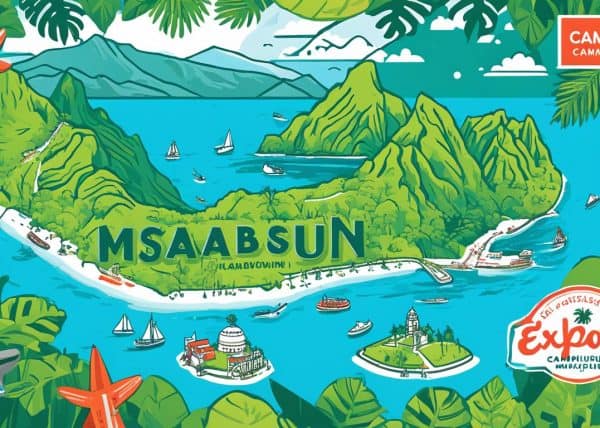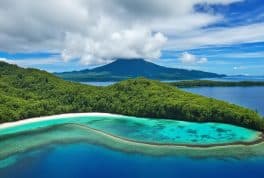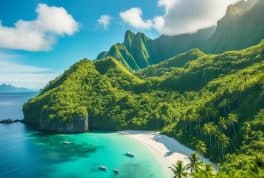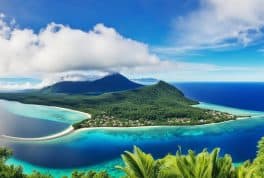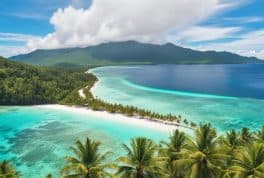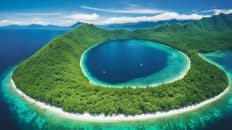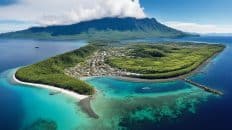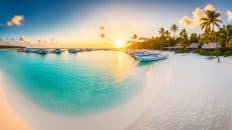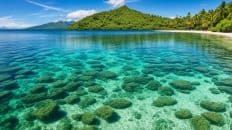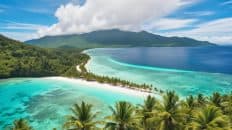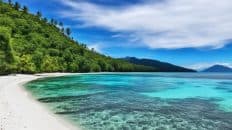Camiguin Island
Camiguin, known as the "Island Born of Fire" in the Philippines, boasts a unique landscape shaped by seven volcanoes, including the active Mount Hibok-Hibok. Renowned for its pristine beaches, like White Island, and natural wonders such as Ardent Hot Springs and the Sunken Cemetery, Camiguin offers a blend of tranquil beauty and rich cultural heritage, exemplified by the celebrated Lanzones Festival. This small yet captivating island is a paradise for nature enthusiasts and those seeking a serene retreat.
Top 10 Things to see in Camiguin
Camiguin Island, often referred to as the "Island Born of Fire," is a treasure trove of natural wonders and historical sites. Here are the top 10 must-see attractions in Camiguin:
- Sunken Cemetery: Perhaps the most iconic landmark of Camiguin, this site was submerged due to a volcanic eruption in the 1870s. A large cross marks the spot, and it's a popular spot for snorkeling and diving, offering a unique underwater experience.
- White Island: An uninhabited white sandbar with stunning views of Mount Hibok-Hibok. It's a perfect spot for sunbathing, swimming, and enjoying panoramic views of the sea.
- Mount Hibok-Hibok: An active volcano offering adventurous hiking trails. The trek to the summit rewards hikers with breathtaking views and a chance to see a variety of flora and fauna.
- Ardent Hot Springs: Nestled at the foot of Mount Hibok-Hibok, these natural hot springs are ideal for a relaxing soak, especially after a day of exploring the island.
- Katibawasan Falls: One of the highest waterfalls in Camiguin, featuring a stunning cascade that drops into a natural pool. It's a great spot for swimming and picnicking.
- Sto. Niño Cold Spring: A refreshing stop, this natural spring pool is known for its cool, crystal-clear waters. It's a popular spot for both locals and tourists looking to beat the tropical heat.
- Mantigue Island Nature Park: A small island off the coast of Camiguin, known for its rich marine life and beautiful coral reefs. It's a great spot for snorkeling, diving, and enjoying pristine beaches.
- Old Spanish Church Ruins: These historical ruins in the town of Catarman are a reminder of Camiguin's past and the 1871 volcanic eruption that destroyed much of the area. The site offers a glimpse into the island's history.
- Tuasan Falls: Another beautiful waterfall located in Camiguin, known for its serene environment and lush surroundings. It's less crowded than Katibawasan Falls, making it a perfect spot for a peaceful retreat.
- Lanzones Festival: If you visit in October, you shouldn't miss the Lanzones Festival, an annual celebration of the island's most popular and sweetest fruit, the lanzones. The festival features street dances, parades, and cultural shows.
Each of these attractions embodies the unique charm of Camiguin, offering a mix of natural beauty, adventure, and cultural richness. Whether you're looking for relaxation, adventure, or a deep dive into local history and culture, Camiguin has something special to offer.
Guides and Tours
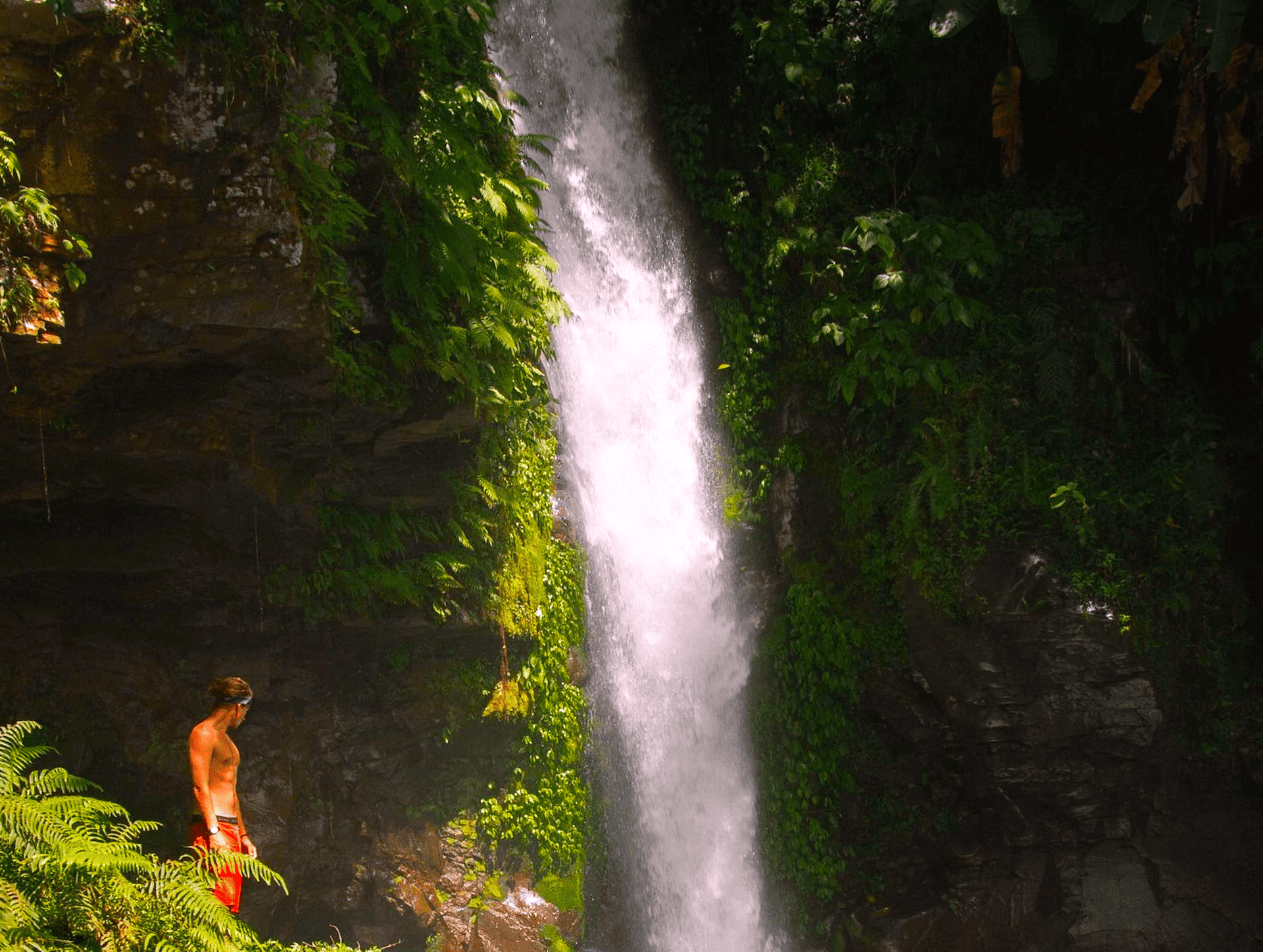
Top 10 Questions and Answers about Camiguin
- What is Camiguin known for?
- Camiguin is known for its stunning natural landscapes, including seven volcanoes, pristine white sand beaches, and lush rainforests. It's famous for the Sunken Cemetery, the Lanzones Festival, and unique attractions like Ardent Hot Springs and White Island.
- How do I get to Camiguin?
- You can reach Camiguin by air via Camiguin Airport, with flights connecting mainly from Cebu City. Alternatively, ferries operate from nearby places like Cagayan de Oro and Bohol, providing scenic sea routes to the island.
- What are the top tourist spots in Camiguin?
- Key attractions include the Sunken Cemetery, White Island, Mount Hibok-Hibok, Ardent Hot Springs, Katibawasan Falls, and the Sto. Niño Cold Spring. The island is also popular for its beautiful beaches and scuba diving spots.
- When is the best time to visit Camiguin?
- The best time to visit is during the dry season, from March to June, when the weather is sunny and ideal for outdoor activities. However, visiting during the Lanzones Festival in October is also a great time to experience the island's vibrant culture.
- What are the unique cultural aspects of Camiguin?
- Camiguin's culture is a blend of indigenous and Spanish influences. The Lanzones Festival, celebrating the harvest of the local lanzones fruit, is a cultural highlight. The island's cuisine, festivals, and local practices also reflect its rich cultural heritage.
- Are there any conservation efforts in Camiguin?
- Yes, Camiguin is active in environmental conservation. Efforts include protecting marine sanctuaries, promoting eco-friendly tourism practices, and engaging in reforestation and wildlife conservation projects.
- What activities can I do in Camiguin?
- Activities include hiking to volcanic peaks, exploring waterfalls, relaxing in hot springs, enjoying white sandy beaches, scuba diving, snorkeling, and experiencing local festivals and cuisine.
- What kind of accommodations are available in Camiguin?
- Camiguin offers a range of accommodations, from luxury resorts and boutique hotels to budget-friendly guesthouses and homestays. Eco-lodges and beachfront accommodations are also popular options.
- Is Camiguin a family-friendly destination?
- Absolutely! Camiguin is suitable for families, offering safe beaches, nature trails, and attractions like waterfalls and springs that are enjoyable for all ages. The island's serene and welcoming atmosphere makes it ideal for a family vacation.
- What should I know about local customs in Camiguin?
- Respect for local customs and traditions is important. Politeness, modesty in dress, especially in religious sites, and an openness to local practices will enhance your experience. The people of Camiguin are known for their hospitality and friendliness.
Remember, each visit to Camiguin offers an opportunity to explore and discover something new, whether it's in the heart of its natural wonders, the depth of its cultural traditions, or the warmth of its local community.
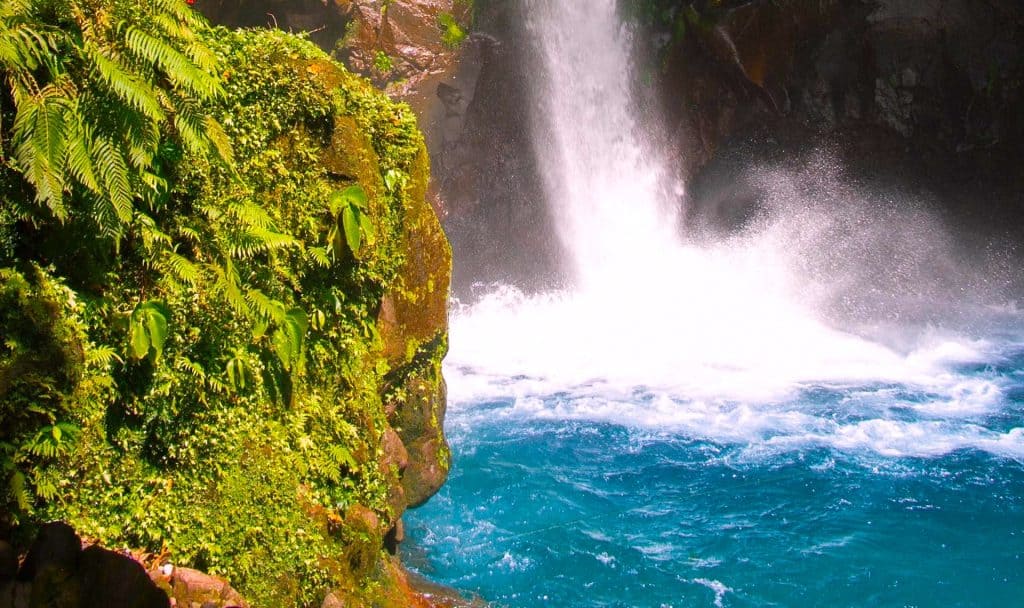
Why you should visit Camiguin
Discovering the Hidden Gem of the Philippines: A Journey to Camiguin
The enchanting island of Camiguin, nestled in the Bohol Sea of the Philippines, is a destination that deserves more than just a passing glance. It’s a place where the harmony of nature, culture, and history creates an experience that captivates the heart of every traveler. In this comprehensive review, we explore why Camiguin stands out as a must-visit destination, offering a blend of serene beauty, rich heritage, and unique adventures.
The Natural Splendor of Camiguin
A Haven of Volcanic Wonders: Camiguin, often dubbed as the “Island Born of Fire”, is home to seven volcanoes, including the active Mount Hibok-Hibok. The volcanic landscape of Camiguin shapes much of its topography – from fertile lands to hot springs and waterfalls. Trekking up the Hibok-Hibok Volcano offers not only a challenging adventure but also rewards hikers with panoramic views of the island and the surrounding sea.
Pristine Beaches and Marine Life: The island boasts some of the most beautiful white sandy beaches in the Philippines. White Island, an uninhabited sandbar, is a haven for sunbathers and those seeking a quiet spot to enjoy the sea. Moreover, Camiguin’s marine biodiversity is a treasure trove for snorkelers and divers, with its vibrant coral reefs and rich marine life, including the giant clams in its clam sanctuary.
The Cultural Tapestry of Camiguin
Festivals and Traditions: Camiguin’s culture is a vibrant mix of history and traditions, most vividly showcased in its local festivals. The Lanzones Festival, celebrated with great pomp and show, is a testament to the island's agricultural heritage and community spirit. It features street dances, parades, and a display of local customs that are both enchanting and educational.
Culinary Delights: The island’s cuisine is a delightful experience for food lovers. Fresh seafood, tropical fruits like the sweet lanzones, and local dishes offer a taste of Camiguin’s culinary richness. Dining here isn’t just about the food; it's about experiencing the local way of life.
The Historical Significance of Camiguin
A Walk Through Time: Camiguin’s history is deeply embedded in its landscape. The Sunken Cemetery, submerged due to a volcanic eruption, is a hauntingly beautiful site that tells a story of resilience. The Old Spanish Church Ruins in Gui-ob offer a glimpse into the island’s colonial past, standing as silent witnesses to the history that shaped Camiguin.
The Evolution of Settlements: From its early days as a small community to its present status as a tourist haven, the settlement of Camiguin has grown while retaining its charm and tranquility. The historical evolution of the island is not just in its physical remnants but also in the traditions and practices of its people.
The Adventure Awaits in Camiguin
Thrills for Every Adventurer: Whether it’s hiking the rugged terrains of its volcanoes, exploring the depths of the sea, or relaxing in the Ardent Hot Springs, Camiguin offers adventures for everyone. For the more daring, diving into the waters of the Sunken Cemetery provides an unparalleled experience.
Eco-friendly Experiences: Camiguin’s commitment to environmental conservation is evident in its eco-tourism initiatives. From guided nature walks to responsible diving practices, the island promotes sustainable tourism, ensuring that its natural beauty is preserved for future generations.
The Warmth and Hospitality of Camiguin
A Welcoming Community: The people of Camiguin are known for their warmth and hospitality. Visitors are welcomed not just as tourists but as friends. The sense of community here is strong, and as a visitor, you’ll feel part
of this close-knit family. Engaging with locals, whether through a shared meal or a village tour, provides insights into the authentic Camiguin way of life.
Safe and Serene: Safety is a paramount concern for any traveler, and Camiguin excels in offering a secure environment. The island maintains a peaceful atmosphere, allowing visitors to explore and relax without worry. The local authorities and community members work together to ensure the safety and comfort of all visitors.
The Quintessential Island Experience
Blend of Relaxation and Excitement: Camiguin strikes a perfect balance between relaxation and adventure. You can spend a day lounging on the serene beaches of White Island and then embark on an exhilarating climb up Mount Hibok-Hibok the next day. This versatility makes Camiguin an ideal destination for all types of travelers.
A Photographer's Paradise: For those who love capturing moments, Camiguin is a paradise. Every corner of the island offers a picturesque scene – from the vibrant festivities and historical landmarks to the breathtaking natural landscapes. The island’s scenic beauty ensures that you’ll leave with a camera full of memories.
Embracing Sustainable Tourism
Preservation of Natural Wonders: Camiguin’s commitment to preserving its natural environment is commendable. The island’s efforts in maintaining its beaches, forests, and springs, along with initiatives like the clam sanctuary, reflect a deep respect for nature. By visiting Camiguin, you contribute to these conservation efforts, as the island reinvests in sustainable tourism practices.
Eco-Friendly Accommodations: Staying in Camiguin is an experience in itself, with numerous eco-friendly accommodations available. These lodgings not only provide comfort but also ensure that your stay has a minimal environmental impact. From solar-powered resorts to eco-lodges, Camiguin’s accommodations are aligned with its ethos of sustainability.
Conclusion: Camiguin – A Journey for the Soul
In conclusion, Camiguin is more than just a travel destination; it’s a journey for the soul. Its combination of natural beauty, rich culture, historical depth, and commitment to sustainability makes it a standout destination. In Camiguin, you find not just a place to visit, but a world to explore, a community to engage with, and experiences that resonate long after the trip is over.
Every visit to Camiguin offers something new – a discovery, an adventure, a moment of peace, or a connection with nature and history. Whether it’s through the tranquil beaches, the festive streets, the lush landscapes, or the warm smiles of its people, Camiguin welcomes you with open arms. So, pack your bags and set out on a journey to this hidden gem of the Philippines, where every moment is an opportunity to discover something beautiful, something unforgettable – Camiguin.
Getting to Camiguin
Getting to Camiguin, an island province in the Philippines known for its natural beauty and serene environment, involves a combination of air and sea travel, depending on your starting location. Here's a guide on how to get to Camiguin:
1. By Air
- Via Camiguin Airport: Camiguin has its own airport, the Camiguin Airport (IATA: CGM), located near Mambajao, the capital town of the island.
- From Manila: There are no direct flights from Manila to Camiguin. Travelers usually fly to Cagayan de Oro City or Cebu City and then take a connecting flight or ferry to Camiguin.
- From Cebu City: Direct flights from Cebu to Camiguin are available. Airlines like Cebu Pacific and Philippine Airlines operate flights to Camiguin, but schedules may vary, so it's essential to check with the airlines for the latest information.
2. By Sea
- Ferry Services: If you're traveling from Cagayan de Oro, Bohol, or other nearby areas, ferries are a common way to reach Camiguin.
- From Cagayan de Oro: Ferries depart from the port in Cagayan de Oro to Camiguin regularly. The journey takes about 2 to 4 hours, depending on the ferry service.
- From Bohol: There are also ferry connections from Bohol to Camiguin. This route is particularly scenic and enjoyable for those who prefer sea travel.
3. Via Cagayan de Oro (A Common Route)
- Fly to Cagayan de Oro: Many travelers choose to fly to Laguindingan Airport in Cagayan de Oro, which is well-connected with major cities in the Philippines.
- Land Travel to Port: From Cagayan de Oro, you can take a bus or a rented vehicle to reach the port of Balingoan, which is about 2 hours away.
- Ferry to Camiguin: From Balingoan Port, ferries to Benoni Port in Camiguin are available. The ferry trip usually takes about an hour.
4. Local Transportation in Camiguin
- Once you arrive in Camiguin, there are several ways to get around the island.
- Rent a Motorcycle or Scooter: This is a popular option for many tourists as it provides flexibility and convenience.
- Public Transport: Jeepneys and multicabs are available for traveling between towns.
- Hire a Tricycle or a Private Vehicle: For guided tours or more comfortable transportation, hiring a tricycle or a private vehicle with a driver is a good option.
5. Travel Tips
- Check Flight and Ferry Schedules in Advance: Schedules can change due to weather conditions or other factors, so it’s advisable to check them before your trip.
- Book Accommodations in Advance: Especially during peak season or local festivals, it’s wise to book your stay ahead of time.
- Prepare for Sea Travel: If you’re prone to seasickness, take necessary precautions for the ferry journey.
By planning your trip well and considering these travel options, you can have a smooth journey to Camiguin and enjoy all the natural and cultural wonders this beautiful island has to offer.
Top 10 Hotels on Camiguin
- Bintana Sa Paraiso: Known for its boutique hotel experience, offering large, clean rooms with beautiful views and private pools. The resort is praised for its good breakfast and comfortable atmosphere.
- Balai Sa Baibai: A resort that excels in providing an intimate guest house environment, perfect for those seeking escape, intimacy, and romance. The staff is noted for their attentiveness, and the resort offers professional masseuse services and diving opportunities.
- Nypa Style Resort Camiguin: This lodge is appreciated for its seamless services, including motorbike rental and airport transport. The in-resort restaurant, Sapore, receives special mention.
- Nouveau Resort: A first-class resort with well-built properties, interesting artwork, spacious and extremely clean rooms, and a comfortable environment.
- SomeWhere Else Boutique Resort: This resort stands out for its well-stocked amenities, both indoor and outdoor showers, and a daybed with a sofa for lounging outside your room. The resort also offers an outdoor pool and bicycles to rent.
- Camiguin Volcan Beach Eco Retreat & Dive Resort: Appreciated for its relaxing environment and friendly staff. The resort features a deck by the seashore for sunset viewing.
- Camiguin Island Golden Sunset Beach Club: A small hotel known for its peaceful atmosphere and the opportunity to enjoy the sunset by the pool.
- Paras Beach Resort: Offers a peaceful escape with a serene atmosphere, ideal for relaxing in gazebo chairs or enjoying the sunset by the pool.
- Bahay Bakasyunan Sa Camiguin: Known for providing a memorable stay with clean and well-maintained rooms and excellent views.
- Seascape Dive Resort: This specialty resort is appreciated for its good bedding and bathroom facilities.
Camiguin Facts
1: Introduction to Camiguin
Nestled in the Bohol Sea, south of the Philippines' archipelago, lies the enchanting island of Camiguin. Often hailed as a hidden gem in Southeast Asia, Camiguin, with its rich history, vibrant culture, and breathtaking natural beauty, offers a unique blend of experiences for travelers. The island, belonging to the Northern Mindanao region, is a remarkable destination, distinguished not only by its scenic landscapes but also by its compelling past. From the first major Spanish settlement to the time when the Philippines gained independence, Camiguin has played a pivotal role in the tapestry of the country's history.
The story of Camiguin is one of resilience and beauty. Known affectionately as the "Island Born of Fire", Camiguin's landscape has been sculpted by volcanic activity, with seven volcanoes, including the still-active Mount Hibok-Hibok, dominating its terrain. This volcanic heritage gives the island its unique geographical features, ranging from hot springs to lush rainforests. Yet, it is not just the volcanoes that make Camiguin extraordinary; it is also the island's stunning white sandy beaches, crystal-clear waters, and the rich tapestry of marine life that dwell within its coral reefs.
Camiguin Island, though small in size, packs a punch with its myriad of natural attractions and historical sites. One of its most famous landmarks is the Sunken Cemetery, a hauntingly beautiful site that serves as a solemn reminder of the island's volatile past. Submerged in the sea due to a volcanic eruption, this site is now marked by a huge cross, standing as a poignant memorial to the past. Another natural wonder, the Ardent Hot Springs, offers a therapeutic escape, with its warm, mineral-rich waters providing a soothing respite to visitors.
The white sand beaches of Camiguin are perhaps its most iconic feature, with White Island, an uninhabited white sandbar, being a must-visit. Accessible only by boat, this strip of white sand beach offers unobstructed views of the island's volcanic peaks and is a perfect spot for sunbathing and snorkeling. The island’s coastal beauty extends underwater, where scuba diving enthusiasts can explore vibrant coral reefs teeming with diverse marine life.
As a testament to its historical significance, Camiguin houses several heritage sites, including the ruins of ancient Spanish churches. These church ruins, particularly the old Spanish church remains, stand as silent witnesses to the island's colonial past and the Spanish settlement that once thrived here. The bell tower of one of these churches, still standing, resonates with the history of the colonial resistance and the island’s journey to independence.
Camiguin’s story is also told through its festivals and cultural celebrations. The Lanzones Festival, for instance, is a vibrant event celebrating the harvest of the island’s most famous fruit. This festival not only showcases the local population's agricultural prowess but also their deep-rooted cultural traditions and joyous spirit. The island's cuisine, too, is a reflection of its rich heritage, with dishes like the leftover boiled rice turned into delightful local delicacies, capturing the essence of the island's culinary landscape.
The small island of Camiguin is not only a testament to nature's beauty but also to the resilience and warmth of its people. Born from fire and sculpted by time, Camiguin has emerged as a premier tourist spot in the Philippines. Whether it's the allure of its white sandy beaches, the mystery of its sunken cemetery, the tranquility of its hot springs, or the echoes of its church ruins, Camiguin invites travelers to immerse themselves in its unique charm.
Beyond its natural and historical offerings, Camiguin is also making strides in modern tourism infrastructure. With facilities like Camiguin airport improving accessibility, the island is now more connected than ever to major cities like Cebu City and Cagayan de Oro. The development of Camiguin hotels and resorts has also seen a rise, catering to the growing number of tourists seeking both luxury and eco-friendly accommodations. Not to mention, the implementation of the Camiguin QR code system exemplifies the island's commitment to sustainable and responsible tourism.
As a volcanic island, Camiguin also offers a glimpse into the dynamic forces of nature. The whole island and province, with its volcanic eruptions and geological changes, serves as a natural laboratory for understanding our planet's inner workings. The Ardent Hot Spring, with its naturally heated waters, is a direct consequence of this geothermal activity, providing a unique and natural spa experience.
Camiguin's story is also intricately linked to the sea. The island, surrounded by the rich waters of the Bohol Sea, relies heavily on the sea for sustenance and recreation. The sea level around Camiguin plays a crucial role in determining the accessibility of certain tourist spots, like the White Island, especially during low tide. This intimate connection with the sea level is evident in the local lifestyle, cuisine, and customs.
The island's provincial government has played a significant role in preserving Camiguin's natural and cultural heritage. Efforts to declare Camiguin as a separate province, distinct from the nearby Misamis Oriental and Lanao provinces, have been instrumental in focusing developmental and conservation efforts specifically tailored to the island's unique needs. This has helped in maintaining Camiguin's charm and appeal as a tourist destination.
Camiguin's journey through time, from its first Spanish settlement to its current status as a thriving island province, is a story of transformation and perseverance. The island's volcanic origins have given rise to a landscape of extraordinary beauty and diversity. From the sandy shores of White Island to the steaming waters of Ardent Hot Springs, from the historic ruins of old Spanish churches to the vibrant celebrations of the Lanzones Festival, Camiguin offers a mosaic of experiences that are as diverse as they are captivating.
In conclusion, Camiguin is not just an island; it is a living, breathing testament to the enduring spirit of nature and humanity. With each volcanic eruption, each wave that laps against its shores, and each festival that lights up its streets, Camiguin continues to weave its story – a story that beckons travelers from around the world to come and be a part of its continuing saga. Whether you're a history enthusiast, nature lover, adventure seeker, or just in need of a peaceful retreat, Camiguin, with its myriad attractions and enduring charm, is a destination that promises an unforgettable experience.
2: The Geography and Natural Beauty of Camiguin
Camiguin, a small island province in the Philippines, is a place where nature's artistry is on full display. This island, born of fire, is a geological wonder, shaped by the powerful forces of volcanic activity. With its seven volcanoes, including the famous Mount Hibok-Hibok, Camiguin is a testament to the dynamic and ever-changing nature of our planet. The island's diverse landscape, characterized by lush forests, rugged mountains, and serene beaches, creates a picturesque setting that captivates visitors from around the globe.
The volcanic origins of Camiguin have bestowed upon it a unique and varied topography. The island's northern coast, facing the Bohol Sea, is adorned with white sandy beaches and coral stones that contrast sharply with the deep blue of the sea. These beaches, such as the renowned White Island, are not only visually stunning but also offer a serene escape from the hustle and bustle of daily life. The White Island, a sandbar that appears and disappears with the tides, is particularly notable for its powdery white sand beach, coral stones and the panoramic view it offers of the volcanic island.
"Camiguin island's volcanic landscape has also created a rich underwater world. The coral reefs surrounding the island are a diver's paradise, teeming with a diverse array of marine life. Scuba diving in Camiguin is a unique experience, as one gets to explore the vibrant coral gardens, swim alongside colorful fish, and even encounter giant clams. These coral reefs not only add to the island's natural beauty but also play a crucial role in sustaining the marine ecosystem.
The hot springs of Camiguin are another byproduct of its volcanic activity. The Ardent Hot Springs, nestled at the foot of Mount Hibok-Hibok, are a popular attraction. These natural hot springs, with their warm, sulfuric waters, are believed to have therapeutic properties and offer a relaxing experience to visitors. The contrast between the hot springs and the nearby cold springs, such as the Sto. Niño Cold Spring, highlights the island's diverse natural offerings.
The volcanic activity on Camiguin has not always been benign, however. The Sunken Cemetery, now marked by a large cross standing in the sea, is a poignant reminder of the island's tumultuous past. Submerged due to a volcanic eruption, this site has become a symbol of Camiguin's resilience in the face of natural disasters. It the sunken cemetery now serves as a solemn attraction, inviting visitors to reflect on the power of nature and the impermanence of human endeavors.
Camiguin's rich volcanic soil supports a lush, tropical rainforest, home to a variety of flora and fauna. The dense forests of Mount Hibok-Hibok and other mountains provide a haven for nature lovers and hikers. Trekking through these forests, one can encounter a myriad of plant species, hear the calls of exotic birds, and perhaps even spot rare wildlife. These forests not only contribute to the island's natural beauty but also play a vital role in maintaining its ecological balance.
The island's natural beauty extends beyond its land and sea. The sky above Camiguin offers a breathtaking display, especially during sunrise and sunset. The view of the sun rising or setting against the backdrop of the island's volcanic peaks is a sight to behold. Photographers and nature enthusiasts flock to tourist spots like White Island and the highlands of Camiguin to capture these magical moments.
Camiguin's geography has also shaped its cultural and historical identity. The volcanic island has been a witness to centuries of human settlement, from the first Spanish settlement to the present day. The island's strategic location in the Bohol Sea made it an important outpost during the colonial era, and remnants of this past can still be seen in the form of ancient Spanish church ruins and other historical sites.
The natural attractions of Camiguin are not limited to its volcanic features. The island is home to stunning waterfalls, such as Katibawasan Falls and Tuasan Falls, which offer a refreshing escape and a chance to immerse oneself in nature. These waterfalls, set amidst lush greenery, are perfect spots for picnics, swimming, and enjoying the tranquility of the island.
The geological and natural richness of Camiguin is a significant factor in its appeal as a tourist destination. The island's small size belies the diversity of experiences it offers. From relaxing on white sandy beaches to exploring coral reefs, from soaking in hot springs to trekking through rainforests, Camiguin provides a plethora of options for nature lovers, adventure seekers, and those looking for a peaceful retreat.
The island's commitment to preserving its natural beauty is evident in its environmental conservation efforts. The local government and community groups work tirelessly to protect the coral reefs, forests, and other natural habitats. Sustainable tourism practices are encouraged, ensuring that the island's natural treasures can be enjoyed by future generations.
In conclusion, the geography and natural beauty of Camiguin are integral to its charm and allure. The island's volcanic origins have given rise to a landscape that is both dramatic and serene. The combination of mountains, forests, beaches, and springs creates a mosaic of natural wonders that delights the senses. As a destination, Camiguin offers a unique opportunity to connect with nature, experience the power of the earth's natural forces, and find solace in the beauty of the natural world. Whether one is seeking adventure, relaxation, or a deeper understanding of our planet, Camiguin, with its mesmerizing geography and natural splendor, is a destination that should not be missed.
3: Historical Significance of Camiguin
The island of Camiguin, a jewel in the crown of the Philippines, is not only a paradise for nature lovers but also a treasure trove of history. This small island, nestled in the Bohol Sea of Northern Mindanao, carries a rich historical tapestry that is as intriguing as its natural beauty. From its earliest days as a significant Spanish settlement to its role in the Philippines' journey to independence, Camiguin's history is a fascinating narrative of resilience, transformation, and cultural amalgamation.
3.1 The Spanish Era and Colonial Resistance
Camiguin's historical journey begins with its first major Spanish settlement. The island played a crucial role during the Spanish colonial era, serving as a strategic point in the Philippines. The remnants of this period are evident in the ancient Spanish church ruins scattered across the northern coast of the island. These ruins, including the Old Spanish Church, are silent witnesses to a bygone era and speak volumes about the island's colonial past.
The bell tower of one of these churches, still standing tall against the backdrop of Camiguin's lush landscapes, is a poignant reminder of the island's historical significance. The Spanish influence extended beyond architecture and religion; it also left indelible marks on the local culture and traditions, weaving a rich tapestry of heritage that continues to define Camiguin today.
However, the Spanish era was not just about cultural exchange; it was also a time of colonial resistance. The people of Camiguin, like many others in the Philippines, were part of the struggle against Spanish rule. This period of resistance played a significant role in shaping the island's identity and its eventual path to becoming part of an independent Philippines. The heritage sites on Camiguin serve as a testament to this tumultuous yet pivotal chapter in the island's history.
3.2 The Road to Independence
The narrative of Camiguin took a dramatic turn with the Philippines' fight for independence. The island, with its strategic location, became a microcosm of the broader independence movement that swept across the country. This period was marked by significant political and social changes, reshaping Camiguin's identity and its role in the newly independent Philippines.
The transition from a Spanish colony to an independent nation brought about profound changes in Camiguin's governance and societal structure. The island's journey mirrors the larger story of the Philippines' struggle for sovereignty and self-determination. The provincial government of Camiguin, established post-independence, played a crucial role in navigating these changes and steering the island towards progress and development.
3.3 Camiguin's Cultural Evolution
The cultural landscape of Camiguin is a vibrant mosaic shaped by its historical experiences. The island's culture is a unique blend of indigenous traditions and influences from its colonial past. The local population of Camiguin, with their distinct customs and practices, reflects this rich cultural heritage.
One of the most vivid expressions of Camiguin's culture is its festivals, with the Lanzones Festival being the most renowned. This festival, celebrated with great enthusiasm, is not only a showcase of the island's agricultural bounty but also a colorful display of its cultural heritage. The festival features traditional music, dance, and costumes, encapsulating the island's spirit and its people's connection to their land and history.
Camiguin's cuisine also tells a story of its historical journey. Traditional dishes, often featuring seafood and local produce, bear the influences of Spanish culinary traditions. The island's signature dish, made from leftover boiled rice, is a testament to the resourcefulness and creativity of its people. This dish, along with other local delicacies, offers a taste of Camiguin's rich cultural tapestry.
3.4 The Legacy of the Past
The historical legacy of Camiguin is not confined to its physical remnants; it is also alive in the island's daily life. The ancient Spanish church ruins, the old town bell tower, and other historical sites are not just as tourist spots and attractions; they are integral to the island's identity. They serve as a bridge connecting the past to the present, reminding the inhabitants and visitors of Camiguin's journey through time.
The heritage sites on Camiguin are also a source of pride for the local community. They are a testament to the island's resilience and its ability to adapt and thrive amidst the tides of history. The preservation of these sites is a priority for the provincial government, ensuring that they continue to tell Camiguin's story to future generations.
3.5 Conclusion
In conclusion, the historical significance of Camiguin is as diverse and captivating as its natural beauty. The island's history, marked by colonial rule, resistance, and transformation, has shaped its unique cultural identity. From the ruins of ancient Spanish churches to the vibrant celebrations of the Lanzones Festival, every aspect of Camiguin tells a part of its historical narrative.
Camiguin is not just an island; it is a living museum, a testament to the enduring spirit of its people and their journey through time. As visitors explore the island, they are not just experiencing its natural wonders; they are also walking through the pages of its rich history. Camiguin's story, etched in its landscapes, ruins, and traditions, continues to enchant and inspire, making it a destination that transcends the boundaries of time and space.
The island of Camiguin, with its historical depth and cultural richness, stands as a beacon of the Philippines' diverse heritage. It is a place where the past and present coexist, offering a window into the soul of this beautiful country. As Camiguin continues to evolve and grow, it remains rooted in its history, proudly carrying the legacy of its past into the future.
4: Camiguin’s Culture and Festivals
Camiguin, a small yet vibrant island in the Philippines, is a place where culture and traditions are deeply woven into the fabric of everyday life. The island's rich history, marked by various influences, has cultivated a unique cultural identity that is celebrated through its festivals, customs, and cuisine. This blend of indigenous heritage and historical influences makes Camiguin a fascinating destination for those seeking to immerse themselves in authentic Filipino culture.
4.1 Lanzones Festival: A Celebration of Harvest and Heritage
One of the most significant cultural events in Camiguin is the Lanzones Festival. Celebrated annually, this festival honors the bountiful harvest of lanzones, a tropical fruit that is a major agricultural product of the island. The festival is not only a celebration of the harvest but also a showcase of Camiguin's rich cultural heritage.
During the Lanzones Festival, the streets of Camiguin come alive with vibrant parades, colorful costumes, and traditional dances. The festival is a visual spectacle, with participants adorned in costumes inspired by local folklore and the island's natural beauty. The sound of music fills the air, with traditional instruments and folk songs adding to the festive atmosphere.
The Lanzones Festival is also an opportunity for the island-born population to display their artistic talents. Local craftsmen and artists exhibit their work, ranging from handwoven textiles to intricate carvings, showcasing the island's rich artistic traditions. The festival is a time for communal celebration, where locals and visitors alike come together to enjoy the festivities and partake in the island's cultural offerings.
4.2 Culinary Delights: A Taste of Camiguin's Heritage
The culinary landscape of Camiguin is as diverse as its culture. The island's cuisine is a delightful mix of flavors and influences, reflecting its historical and geographical context. Seafood is a staple, given Camiguin's location in the Bohol Sea, with dishes often featuring the freshest catch from the surrounding waters.
A unique aspect of Camiguin's cuisine is its use of local produce and ingredients. One such example is the leftover boiled rice, which is creatively transformed into various dishes, showcasing the resourcefulness and culinary ingenuity of the local population. This dish, along with other local specialties, offers a glimpse into the island's culinary traditions and the everyday life of its people.
The influence of Spanish cuisine is also evident in Camiguin's food culture. Dishes such as paella and adobo have been adapted to local tastes and ingredients, creating a fusion of flavors that is distinctively Camiguin. The island's culinary offerings provide a delicious way to experience its cultural heritage and are an integral part of any visit to Camiguin.
4.3 Art and Craftsmanship: The Creative Spirit of Camiguin
The artistic heritage of Camiguin is a reflection of its diverse cultural influences and the creative spirit of its people. Local artisans are skilled in various crafts, including weaving, pottery, and woodcarving. These crafts are not just art forms; they are expressions of the island's history and traditions.
Traditional weaving techniques are used to create beautiful textiles, with patterns and designs that are unique to Camiguin. These textiles are often used in traditional clothing and are a source of pride for the island's inhabitants. Pottery and woodcarving are also popular crafts, with artisans creating functional and decorative items that reflect the island's natural beauty and cultural motifs.
The art and craftsmanship of Camiguin are not confined to traditional forms. Contemporary artists on the island are also exploring new mediums and styles, creating works that blend traditional motifs with modern aesthetics. This fusion of old and new reflects the dynamic and evolving nature of Camiguin's cultural landscape.
4.4 Music and Dance: The Rhythms of Camiguin
Music and dance play a central role in the cultural life of Camiguin. These art forms are integral to the island's festivals and celebrations, serving as a means of expression and community bonding. Traditional music in Camiguin is characterized by the use of indigenous instruments and folk melodies, reflecting the island's heritage and natural surroundings.
Dance is another important aspect of Camiguin's culture. Traditional dances often tell stories and convey emotions, with movements inspired by nature and local folklore. These dances are not just performances; they are a way for the island's inhabitants to connect with their history and with each other.
The music and dance of Camiguin are also a means of preserving the island's cultural heritage. Through these art forms, the stories, beliefs, and traditions of the island are passed down from generation to generation, ensuring that Camiguin's rich cultural legacy continues to thrive.
4.5 Conclusion
In conclusion, the culture and festivals of Camiguin are a vibrant tapestry of history, tradition, and creativity. The island's cultural offerings, from the Lanzones Festival to its culinary delights, from its art and craftsmanship to its music and dance, provide a rich and immersive experience for visitors. Camiguin's culture is a reflection of its people's resilience, their connection to the land, and their pride in their heritage.
Camiguin is not just a destination for natural beauty; it is a place where culture comes to life. The island's festivals, traditions, and artistic expressions offer a window into the soul of the Philippines, inviting visitors to explore, celebrate, and be part of its cultural journey. As Camiguin continues to evolve and welcome visitors from around the world, its culture remains a cornerstone of its identity, a source of pride, and a beacon of its enduring spirit.
5: Adventure and Activities in Camiguin
Camiguin, an island province in the Philippines, is not just a place of breathtaking natural beauty and rich cultural heritage; it's also a haven for adventure seekers and nature enthusiasts. This volcanic island, often referred to as the "Island Born of Fire," offers an array of activities that cater to various interests, from underwater explorations to mountain treks, and from soothing hot springs to refreshing waterfalls.
5.1 Underwater Adventures: Scuba Diving and Snorkeling
Camiguin's marine life is as diverse and vibrant as its terrestrial biodiversity. The surrounding coral reefs are a paradise for scuba divers and snorkelers. With clear waters and an abundance of coral species, the reefs around Camiguin are teeming with marine life, including colorful fish, sea turtles, and giant clams. The underwater world of Camiguin offers a mesmerizing experience, with its rich coral gardens and the opportunity to swim alongside a variety of marine creatures.
The island's dive spots cater to all levels of divers, from beginners to experienced. Diving schools and centers provide courses and guided tours, ensuring a safe and enjoyable experience for everyone. For those who prefer snorkeling, the shallow reefs offer a spectacle of marine biodiversity, easily accessible from the shore or by a short boat ride.
5.2 Hiking and Exploration: The Volcanoes of Camiguin
For those who seek adventures on land, Camiguin's volcanic landscape provides ample opportunities. The island's most famous volcano, Mount Hibok-Hibok, offers a challenging yet rewarding trek. The hike to the summit of this active volcano is an exhilarating experience, offering panoramic views of the whole island and the surrounding sea. The path winds through lush forests, past steam vents, and over rugged terrain, showcasing the island's geological diversity.
Apart from Mount Hibok-Hibok, there are other volcanic peaks on the island, each with its unique features. These include Mount Vulcan, known for its historical significance, and other dormant volcanoes that offer more leisurely hikes. These treks not only provide physical challenges but also a chance to witness Camiguin's rich flora and fauna.
5.3 Relaxation and Healing: Hot Springs and Cold Springs
After a day of adventure, Camiguin offers places to relax and rejuvenate. The Ardent Hot Springs, located at the base of Mount Hibok-Hibok, are a popular spot for relaxation. These natural hot springs, with their warm, mineral-rich waters, are believed to have therapeutic properties. Surrounded by natural beauty, the Ardent Hot Springs provide a serene environment to unwind and soothe tired muscles.
In contrast to the hot springs, Camiguin also boasts refreshing cold springs, such as the nino cold spring, springs, spring, springs, spring and the Sto. Niño Cold Spring. These natural pools, with their crystal-clear and cool waters, offer a refreshing escape from the tropical heat. The various nino cold springs, spring and springs are set in picturesque locations, often surrounded by lush vegetation, making them a perfect spot for picnics and relaxation.
5.4 Adventure Sports and Water Activities
>Camiguin island's diverse landscape and rich waters also make it an ideal destination for various adventure sports and water activities. The island offers opportunities for kayaking, paddleboarding, and even parasailing. These activities provide a unique way to explore Camiguin island's coastal beauty and its serene waters.
For those looking for more adrenaline-pumping adventures, Camiguin offers cliff diving and canyoning. These activities, guided by experienced professionals, allow adventurers to explore the island's rugged terrain and pristine waterfalls in an exhilarating way.
5.5 Exploring Waterfalls and Natural Wonders
Camiguin's natural attractions are not limited to its beaches and volcanoes. The island is home to several stunning waterfalls, such as Katibawasan Falls and Tuasan Falls. These waterfalls, set amidst lush greenery, offer a peaceful retreat and a chance to experience Camiguin's unspoiled nature. Visitors can swim in the cool waters, relax by the falls, or simply enjoy the tranquility of these natural settings.
Apart from the waterfalls, Camiguin is also known for its Soda Water Swimming Pool, a unique attraction where the water is naturally carbonated from the soda water springs. This pool, located in the old town part of Catarman, provides a distinctive swimming experience, with its fizzy soda water also believed to have health benefits.
5.6 Conclusion
In conclusion, Camiguin is a destination that offers a wealth of experiences for those seeking adventure, relaxation, and a connection with nature. Whether it's diving into the depths of the sea, trekking up a volcanic peak, soaking in hot springs, or exploring waterfalls, Camiguin has something for everyone. The island's natural beauty, combined with its array of activities, makes it a perfect destination for travelers looking for an unforgettable adventure.
The adventures in Camiguin are not just about thrill-seeking; they are also about appreciating the island's natural wonders and understanding its ecological significance. Through responsible tourism practices and a respect for nature, visitors can enjoy all that Camiguin has to offer while contributing to the preservation of this beautiful island. As Camiguin continues to welcome adventurers from around the world, it remains committed to protecting its natural treasures and sharing its unique beauty with all who visit.
6: Camiguin’s Tourist Infrastructure
Camiguin, a small volcanic island in the Philippines, is renowned not only for its stunning natural beauty and rich cultural heritage but also for its well-developed tourist infrastructure. This infrastructure has been carefully designed to cater to the needs of visitors while preserving the island's pristine environment. From convenient transportation options to a range of accommodation facilities, Camiguin offers a comfortable and enjoyable experience for tourists.
6.1 Accessibility: Reaching the Island of Camiguin
The accessibility of Camiguin has significantly improved over the years, making it a convenient destination for both domestic and international travelers. The island is served by Camiguin Airport, which connects it to major cities like Cebu City and Cagayan de Oro. Regular flights to Camiguin provide an easy and quick way to reach the island, catering to tourists who are short on time.
For those who prefer sea travel, ferries and boats operate from various ports in Mindanao and the Visayas, such as Cebu City and Cagayan de Oro, to Camiguin. The journey by sea offers a scenic route, allowing travelers to enjoy the beauty of the Philippine archipelago. The port of Benoni in Camiguin serves as the main gateway for sea travelers, with regular ferry services available.
Once on the island, getting around is convenient, thanks to the well-maintained roads and available transportation options. Tourists can rent motorcycles, scooters, or cars to explore the island at their own pace. For those who prefer not to drive, local transportation such as tricycles and jeepneys are readily available, providing an authentic Filipino travel experience.
6.2 Accommodations: From Luxury Resorts to Cozy Homestays
Camiguin offers a wide range of accommodations to suit different budgets and preferences. For those seeking luxury, there are high-end resorts and hotels that provide world-class amenities and services. These resorts often feature stunning beachfront locations, offering guests breathtaking views and direct access to Camiguin's beautiful beaches.
For travelers looking for a more authentic and budget-friendly experience, Camiguin has numerous homestays and guesthouses. These accommodations provide a cozy and intimate setting, allowing visitors to experience the local way of life. Many homestays are run by local families, offering guests a unique opportunity to learn about the island's culture and traditions.
Eco-friendly accommodations are also available in Camiguin, catering to environmentally conscious travelers. These establishments focus on sustainability, utilizing renewable energy sources and practicing waste management to minimize their impact on the environment.
6.3 Dining and Cuisine: A Culinary Journey
The culinary scene in Camiguin is as diverse as its culture. The island's restaurants and eateries offer a variety of local and international cuisines, catering to different tastes and dietary requirements. Seafood, freshly caught from the surrounding waters, is a staple in Camiguin's cuisine, and visitors can enjoy a range of seafood dishes at local restaurants.
Camiguin is also known for its sweet lanzones, a tropical fruit that is celebrated during the Lanzones Festival. Many restaurants and eateries feature dishes and desserts made from lanzones, providing a unique culinary experience.
For a more immersive dining experience, visitors can try eating at local markets or street food stalls. These places offer authentic Camiguin dishes at affordable prices, allowing tourists to sample the island's street food culture.
6.4 Sustainable Tourism Practices
The provincial government of Camiguin, along with local businesses, is committed to promoting sustainable tourism practices. Efforts are being made to preserve the island's natural beauty and cultural heritage while accommodating the growing number of visitors.
Sustainable practices include the promotion of eco-friendly accommodations, the implementation of waste management systems, and the protection of marine and wildlife habitats. Tourists are encouraged to be responsible travelers, respecting the local environment and culture.
6.5 Health and Safety: Ensuring a Safe Visit
The health and safety of visitors are of utmost importance in Camiguin. The island is equipped with medical facilities and emergency services to ensure the well-being of tourists. Additionally, local authorities and tourism operators provide safety guidelines and tips, especially for adventure activities like diving and trekking.
The implementation of the Camiguin QR code system is a step towards enhancing tourist safety. This system allows for efficient tracking and management of tourist activities, ensuring a safe and organized travel experience.
6.6 Conclusion
In conclusion, Camiguin's tourist infrastructure plays a crucial role in making the island an attractive and accessible destination for travelers. With its convenient transportation options, a variety of accommodations, diverse culinary offerings, and commitment to sustainable tourism, Camiguin caters to the needs and preferences of a wide range of tourists.
The efforts of the local government and the community in developing and maintaining this infrastructure have been instrumental in promoting Camiguin as a premier tourist destination. As the island continues to welcome visitors from around the world, it remains committed to providing a safe, enjoyable, and sustainable travel experience. Whether it's for relaxation, adventure, cultural immersion, or culinary exploration, Camiguin offers an unforgettable experience for every traveler.
7: Camiguin’s Environmental Consciousness and Conservation Efforts
Camiguin, a small volcanic island in the Philippines, is renowned not only for its stunning natural beauty but also for its commitment to environmental conservation. The island's unique ecosystem, characterized by lush rainforests, diverse marine life, and active volcanoes, is a precious resource that the local community and government strive to protect. Camiguin's environmental consciousness is reflected in its various conservation initiatives and sustainable practices.
7.1 Preserving the Natural Beauty of Camiguin
The natural beauty of Camiguin is its most valuable asset, attracting tourists from all over the world. Recognizing this, the island's provincial government and local organizations have implemented measures to preserve its pristine environment. Efforts include reforestation projects, protection of wildlife habitats, and conservation of marine areas.
Camiguin's rainforests are home to a variety of plant and animal species, some of which are endemic to the island. Conservation programs focused on preserving these forests are crucial in maintaining the island's biodiversity. These programs involve the local community, educating them about the importance of conservation and involving them in reforestation efforts.
Marine conservation is another key focus in Camiguin. The island is surrounded by rich coral reefs that are vital to the health of the ocean's ecosystem. Initiatives such as establishing marine protected areas, regulating fishing practices, and conducting coral reef restoration projects are in place to safeguard these underwater treasures.
7.2 Sustainable Tourism Practices in Camiguin
Sustainable tourism is a cornerstone of Camiguin's approach to environmental conservation. The island promotes eco-friendly tourism practices that minimize the impact on the environment while enhancing the visitor experience. This includes encouraging responsible behavior among tourists, such as proper waste disposal and respect for wildlife.
Accommodations on the island are also encouraged to adopt sustainable practices. This includes using renewable energy sources, implementing water conservation measures, and reducing plastic usage. Many hotels and resorts in Camiguin have embraced these practices, setting an example for sustainable tourism in the region.
7.3 Community Involvement in Environmental Protection
The involvement of the local community is vital to the success of Camiguin's environmental initiatives. The island's inhabitants are encouraged to take an active role in conservation efforts, recognizing that the preservation of their natural environment is essential for their livelihood and well-being.
Educational programs and workshops are conducted to raise awareness about environmental issues and teach sustainable practices. These programs aim to instill a sense of stewardship among the local population, ensuring that they are partners in the effort to protect Camiguin's natural resources.
7.4 Camiguin’s Response to Climate Change
As an island, Camiguin is particularly vulnerable to the effects of climate change, such as rising sea levels and increased frequency of extreme weather events. The local government and community are aware of these challenges and are actively working to mitigate the impact of climate change.
Efforts include strengthening coastal defenses, promoting sustainable land use, and participating in global initiatives to reduce carbon emissions. Camiguin's proactive approach to addressing climate change is a testament to its commitment to protecting its environment for future generations.
7.5 Eco-Tourism Initiatives
Eco-tourism is a growing sector in Camiguin, offering visitors the opportunity to experience the island's natural wonders in a sustainable and responsible manner. Eco-tourism initiatives focus on preserving the natural environment while providing economic benefits to the local community.
Activities such as guided nature hikes, bird watching tours, and snorkeling trips are conducted in a way that minimizes environmental impact. These eco-tourism experiences are not only enjoyable for tourists but also educational, raising awareness about the importance of conservation.
7.6 Conclusion
In conclusion, Camiguin's environmental consciousness and conservation efforts are integral to its identity as a tourist destination. The island's commitment to preserving its natural beauty, promoting sustainable tourism practices, involving the local community in conservation efforts, responding to climate change challenges, and developing eco-tourism initiatives are commendable.
These efforts ensure that Camiguin remains a paradise not only for the current generation of visitors but also for future generations to come. The island sets an example for sustainable tourism and environmental stewardship, showcasing how a delicate balance can be maintained between development and conservation. Camiguin's approach to environmental preservation is a model for other destinations, proving that tourism and environmental responsibility can go hand in hand.
8: Practical Information for Visitors to Camiguin
Camiguin, a captivating island province in the Philippines, is a destination that promises an array of experiences for its visitors. From its rich cultural heritage to its stunning natural landscapes, Camiguin is a place that beckons travelers seeking adventure, relaxation, and cultural immersion. To ensure a fulfilling and hassle-free experience, it's essential for visitors to be equipped with practical information about the island.
8.1 Travel Tips: Best Time to Visit and Weather Considerations
Understanding the best time to visit Camiguin is crucial for planning your trip. The island enjoys a tropical climate, with two distinct seasons: the dry season and the rainy season. The dry season name camiguin, which typically runs from March to June, is considered the best time to visit. During this period, the weather is generally sunny and warm, making it ideal for exploring the island's beaches and natural attractions.
However, Camiguin also has its charm during the rainy season, which lasts from July to December. While there may be occasional showers, they are often short-lived, and the landscape becomes lush and vibrant. Traveling name camiguin during this period also means fewer tourists and potentially lower accommodation prices.
It's important to keep in mind that the weather in Camiguin, like in many tropical destinations, can be unpredictable. Therefore, it's advisable to check the weather forecast and be prepared for sudden changes in conditions.
8.2 Important Locations and Contacts
Familiarizing yourself with key locations on the island, and tourist spots such as the Camiguin airport, major tourist spots, and emergency facilities, is essential. The Camiguin airport is a former location located near Mambajao, the island's capital and largest municipality. This former location is where most visitors will begin their journey on the island.
For emergency situations, it's important to have the contact information of local authorities, medical facilities, and your country's embassy or consulate. The provincial government of Camiguin and tourist information centers can provide assistance and guidance during your stay.
8.3 Health and Safety Guidelines
Health and safety are paramount when traveling to Camiguin. Visitors should be aware of basic health precautions, such as drinking only bottled or purified water and protecting themselves from mosquito-borne diseases. It's also advisable to have travel insurance that covers medical emergencies.
When engaging in outdoor activities like hiking, scuba diving in, or exploring remote areas, always prioritize safety. Follow guidelines provided by local authorities and tour operators, and never venture into restricted areas. It's also wise to inform someone of your plans when heading out for the day, especially if you're traveling alone.
8.4 Navigating the Island: Transportation and Maps
Getting around Camiguin is relatively straightforward due to its small size. Renting a scooter or motorcycle is a popular option for tourists, as it offers flexibility and the opportunity to explore at your own pace. Car rentals and local jeepneys are also available for those who prefer them. When renting vehicles, ensure that you have the proper documentation and understand the local traffic regulations.
Having a map of Camiguin, either in physical form or digitally, is invaluable. Maps can provide information on the location of tourist spots, beaches, resorts, and essential services. Many accommodations provide maps to their guests, and tourist information centers can also assist with navigation advice.
8.5 Cultural Etiquette and Local Customs
Understanding and respecting local customs and etiquette is crucial for a harmonious experience in Camiguin. Filipinos are known for their hospitality and friendliness, but it's important to be mindful of local traditions and practices. Simple gestures like removing your shoes before entering someone's home, greeting people with a smile, and using polite language can go a long way.
When visiting religious sites or participating in local festivals, dress appropriately and respect the customs associated with these events. Always ask for permission before taking photos of people, especially during cultural ceremonies or in rural communities.
8.6 Enjoying Local Cuisine and Dining Etiquette
Sampling local cuisine is an integral part of the travel experience in Camiguin. The island offers a variety of dishes that reflect its rich cultural heritage. When dining in local eateries or at street food stalls, don't hesitate to try something new, but also be aware of your dietary restrictions or allergies.
In terms of dining etiquette, Filipinos are quite informal. However, it's polite to wait for everyone to be served before starting to eat and to use utensils appropriately. In more rural or traditional settings, you may find that eating with your hands is common – embrace it as part of the local experience!
8.7 Conclusion
In conclusion, a trip to Camiguin is a journey into a world of natural beauty, rich culture, and warm hospitality. Being well-prepared with practical information can significantly enhance your experience on this enchanting island. From understanding the best travel
times to respecting local customs, each aspect of your preparation will contribute to a more enjoyable and meaningful visit. Camiguin, with its unique blend of attractions and the friendly nature of its people, offers a memorable experience for all who visit. Whether you're there to bask in its natural wonders, delve into its cultural depths, or simply unwind in its serene ambiance, Camiguin promises a journey that will captivate your heart and leave you with lasting memories. So pack your bags, prepare well, and embark on an adventure to this exquisite island, where every moment is an opportunity to experience something wonderful.
9: Conclusion: The Enchanting Allure of Camiguin
Camiguin, a small island province in the Philippines, is a destination that captures the heart of every visitor with its enchanting allure. This island, often described as an idyllic paradise, is a tapestry of rich history, diverse culture, stunning natural beauty, and environmental consciousness, making it a unique and unforgettable destination. As we conclude our exploration of white island of Camiguin, let us reflect on the myriad aspects of separate province that make this island a must-visit for travelers from around the globe.
9.1 The Natural Splendor of Camiguin
*Camiguin island's natural beauty is arguably its most compelling attraction. The island, with its volcanic origins, boasts a landscape that is both dramatic and serene. From the majestic peaks of its volcanoes, like Mount Hibok-Hibok, to the tranquil shores of its white sandy beaches, Camiguin island offers a diverse range of natural wonders.
The island's hot springs, such as Ardent Hot Springs, and cold springs, like Sto. Niño Cold Spring, provide soothing retreats for relaxation and rejuvenation. The Sunken Cemetery, a unique underwater marvel, reminds visitors of the island's volcanic history while offering a one-of-a-kind snorkeling experience.
Camiguin's rich marine life and vibrant coral reefs make it a haven for scuba divers and snorkelers. The clear waters around the island are home to a diverse array of marine species, offering an underwater spectacle for enthusiasts of all levels.
9.2 Camiguin's Rich Cultural Tapestry
The culture of Camiguin is a vibrant blend of influences from its historical past and the traditions of its island-born population. The island's festivals, most notably the Lanzones Festival, are a riot of color and joy, showcasing the local customs, dances, and music. These festivals not only celebrate the island's agricultural bounty but also strengthen the communal bonds among its people.
The culinary delights of Camiguin, influenced by its history and natural resources, offer a taste of the island's rich heritage. From seafood delicacies to unique creations like dishes made from leftover boiled rice, the local cuisine is a delightful experience for food lovers.
9.3 A Haven for Adventure and Relaxation
Camiguin caters to both the adventure seeker and the leisure traveler. The island's diverse terrain provides opportunities for hiking, trekking, and exploring its natural wonders. At the same time, its serene beaches and springs offer perfect settings for relaxation and contemplation.
The island's commitment to sustainable tourism practices ensures that its natural beauty is preserved while providing visitors with a quality experience. The eco-tourism initiatives in Camiguin are a testament to the island's dedication to environmental conservation.
9.4 The Welcoming Spirit of Camiguin
One of the most enduring aspects of Camiguin is the warm hospitality of its people. Visitors to the island are welcomed with open arms and are often treated like family. This hospitality, coupled with the island's safe and friendly atmosphere, makes Camiguin a destination that many return to time and again.
The community's involvement in preserving the island's natural and cultural heritage is commendable. Their efforts ensure that the beauty and traditions of Camiguin are not only enjoyed by current visitors but also preserved for future generations.
9.5 Navigating Camiguin: An Easy and Enjoyable Experience
The tourist infrastructure in Camiguin, from its accommodations to transportation facilities, is designed to cater to the needs of all travelers. Whether opting for luxury resorts or cozy homestays, visitors can find accommodations that suit their preferences and budgets.
The island's size makes it easy to navigate, allowing visitors to explore its many attractions with ease. The availability of maps, guided tours, and local transportation options ensures a smooth and enjoyable travel experience.
9.6 Conclusion
In conclusion, Camiguin is an
island that truly embodies the essence of a tropical paradise with its unique blend of natural beauty, rich culture, and warm hospitality. Its diverse landscape offers a plethora of experiences, from the tranquility of its beaches to the adventure of its volcanic landscapes. The cultural experiences, from vibrant festivals to the savory delights of its cuisine, add depth and color to the Camiguin experience.
As a destination, Camiguin stands out for its commitment to sustainable tourism and environmental conservation, ensuring that its natural wonders are preserved for future generations to admire. The proactive involvement of the local community in these efforts is not only inspiring but also pivotal in maintaining the island's ecological balance and cultural integrity.
The welcoming nature of the people of Camiguin island adds an intangible value to every visit. Their hospitality and genuine warmth make every interaction memorable and foster a sense of belonging among visitors. This, combined with the safe and serene environment of the island, makes Camiguin island not just a travel destination but a place that touches the soul.
Moreover, the ease of navigating the island and the range of accommodation options available make Camiguin accessible and enjoyable for all types of travelers. Whether seeking a luxurious getaway or a budget-friendly adventure, visitors can find just what they are looking for in Camiguin.
Camiguin, with its enchanting allure, offers more than just a getaway; it offers an experience that captivates the heart and rejuvenates the spirit. It's a place where the beauty of nature, the richness of culture, and the warmth of community come together to create a symphony of unforgettable experiences. For those who seek a destination that offers both tranquility and adventure, cultural richness and natural splendor, Camiguin is the perfect choice.
In essence, Camiguin is not just a location on the map; it's a journey, an experience, and a memory that lasts a lifetime. It's a place where every sunset is a reminder of the day's beauty, and every sunrise brings the promise of new adventures. As you leave Camiguin, you take with you not just photographs, but stories, experiences, and a piece of this enchanting island that will call you back, time and again.
10: Appendices
As we conclude our comprehensive exploration of the enchanting island of Camiguin, it's pertinent to provide additional information that might be of interest to potential visitors and enthusiasts of this idyllic destination. This section aims to enrich the understanding of Camiguin by offering further insights and practical details that complement the main content of the article.
10.1 Additional Information
- Camiguin Zip Code: For those needing postal services during their stay, it's useful to note that the zip code for Mambajao, the capital of Camiguin, is 9100. This information is vital for sending or receiving parcels and correspondence.
- Travel Routes: Camiguin is accessible via various routes. Popular ones include the sea route from Cagayan de Oro to Camiguin, which offers a scenic and tranquil journey. Another popular route is from Cebu City, connecting travelers from the Visayas region to this Northern Mindanao gem.
- Old Kinamiguin Word and Visayan Word: The linguistic heritage of Camiguin is rich and diverse. The old Kinamiguin word, rooted in the indigenous language of the island, and Visayan words, reflect the cultural and historical tapestry of Camiguin. These languages contribute to the island's unique identity and offer a glimpse into its past.
10.2 Glossary of Local Terms
- Hibok-Hibok: Refers to an active volcano on Camiguin Island, known for its majestic presence and historical eruptions.
- Lanzones: A tropical fruit that is celebrated in Camiguin, especially during the Lanzones Festival. It is known for its sweet and tangy flavor.
- Benoni Port: The main port in Camiguin, serving as a gateway for travelers coming in and going out of the island via sea.
10.3 Further Reading and References
For those interested in delving deeper into the wonders of Camiguin, a variety of resources are available. Travel guides, both printed and online, offer detailed insights into the island's attractions, accommodations, and dining options. Documentaries and travel vlogs available on various platforms provide visual and experiential insights into what it's like to explore Camiguin.
Local histories and cultural studies are available for those interested in the historical and sociological aspects of Camiguin. These resources provide a deeper understanding of the island's past, its people, and their way of life.
10.4 Final Thoughts
In summary, Camiguin is more than just a destination; it's a journey into a world where nature's beauty is in harmony with a rich cultural tapestry and a community that warmly embraces its visitors. The island's volcanic landscapes, pristine beaches, lush rainforests, and vibrant marine life offer an escape to a natural paradise, while its festivals, cuisine, and friendly locals provide a cultural immersion like no other.
Camiguin's commitment to preserving its natural and cultural heritage while welcoming visitors from around the world sets it apart as a model for sustainable and responsible tourism. Whether it's for adventure, relaxation, or cultural exploration, Camiguin offers a plethora of experiences that cater to a wide range of preferences and interests.
As you consider your next travel destination, let the allure of Camiguin beckon you to its shores, where every moment is an opportunity to create memories that will last a lifetime. In the words of those who have walked its paths and swam in its waters, Camiguin is not just a place you visit; it's a place that stays with you long after you've left its shores.
In conclusion, Camiguin is a testament to the beauty and resilience of the Philippines. It's a place where each sunrise promises new adventures, and every sunset leaves you longing for more. From the depths of its waters to the peak of Hibok-Hibok, every corner of Camiguin tells a story, waiting to be discovered and cherished.
11: Exploring the Depths of Camiguin's Attractions
Camiguin, a verdant island in the Philippines, is not only a place of natural beauty but also a land rich in history and culture. This section delves into the less explored yet equally fascinating attractions of Camiguin, offering a deeper understanding of just what makes this island truly unique.
The Unseen Wonders of Camiguin
Clam Sanctuary: Camiguin’s commitment to preserving its marine life is exemplified in its clam sanctuary. Located in the pristine waters surrounding the island, this sanctuary is dedicated to the protection and study of giant clams. These magnificent sea creatures, essential to the health of white island and coral reefs, are a sight to behold and a testament to the island's dedication to environmental conservation.
Soda Springs: Another unique feature of Camiguin is its soda springs, notably the Bura Soda Water Swimming Pool. These springs are naturally carbonated, due to the volcanic activity of the island. Locals and tourists alike are often found here, enjoying the unique experience of swimming in effervescent soda water, that is both refreshing and believed to have therapeutic properties.
Hibok-Hibok Volcano: As an island born of fire, Camiguin’s landscape is dominated by the majestic Hibok-Hibok Volcano. This active volcano, a part of the Pacific Ring of Fire, offers challenging trails for hikers and a chance to witness the raw beauty of nature. The trek to the crater reveals stunning panoramic views and a unique landscape shaped by centuries of volcanic activity.
Historical Insights: The settlement of Camiguin has grown and evolved significantly over the years. The island, once called "Katagman" by its early settlers, reflects a history that is rich and diverse. From its days as a Spanish stronghold to its current status as a thriving tourist destination, Camiguin's development is a narrative of resilience and growth.
Cultural Celebrations: Camiguin's history is formally inaugurated in its festivals and cultural events. The Lanzones Festival, in particular, is a vibrant celebration that marks the harvest of the island’s sweet lanzones fruit. During this festival, the streets of Camiguin come alive with color, music, and dance, showcasing the island's rich cultural tapestry.
Beyond the Beaten Path
Old Volcano: The Old Volcano, also known as Mount Vulcan, is another significant landmark in Camiguin. This dormant volcano, with its historical and geological significance, offers a gentler trek compared to Hibok-Hibok. The Old Volcano’s slopes are home to the Stations of the Cross, making it a site of religious pilgrimage, especially during Holy Week.
Usher in the Day: Mornings in Camiguin are a time to usher in the day with a tranquil sunrise. Visitors often start their day with an 'usher breakfast', a local term for the first meal of the day, enjoyed while watching the sunrise over the ocean or the mountains. This meal often includes local delicacies and the freshest fruits, including the famed lanzones.
Northern Connections: While Camiguin is a self-contained paradise, its proximity to
other regions like Surigao del Norte adds to its charm. Day trips or extended tours to nearby areas such as Surigao del norte offer an extended experience of the rich cultural and natural heritage of this part of the Philippines. The seamless blend of experiences makes the journey through Camiguin and its neighboring regions a comprehensive insight into the diverse beauty of the country.
Embracing the Future
As Camiguin continues to welcome visitors from around the globe, it stands at a crossroads of preserving its natural wonders and cultural heritage while embracing modernity and development. The island's tourist spots, from the clam sanctuary to the soda springs, and from the majestic Hibok-Hibok Volcano to the historical remnants of the old volcano, each tell a story of a land shaped by time, nature, and human endeavor.
The settlement of Camiguin has grown from a small community to a bustling tourist destination, yet it has managed to retain its charm and tranquility. The island's festivals and cultural events, like those celebrating its ancient name 'Katagman', continue to weave the old with the new, celebrating its rich history while looking forward to a future of sustainable growth and development.
Conclusion
In summary, Camiguin is an island that offers more than just picturesque landscapes and serene beaches. It is a place where history comes alive, culture is celebrated, nature is revered, and the future is embraced with optimism and responsibility. Whether it is through the preservation efforts in its clam sanctuary, the unique experiences offered by its soda springs, the awe-inspiring vistas from Hibok-Hibok Volcano, or the reflective journey through the old volcano, Camiguin is a destination that promises a holistic and enriching experience.
Each visit to Camiguin is an opportunity to explore and discover, to relax and rejuvenate, and to connect with a land that is as diverse in its offerings as it is unified in its welcome. So, pack your bags and set your sights on Camiguin, where every corner holds a new adventure and every moment is a step closer to nature and history.
12: Delving Deeper into Camiguin's Tourist Spots and Historical Growth
Camiguin, an island province in the Philippines, is not just a destination; it's a journey into a world where nature's splendor meets human history and culture. This section delves deeper into the essence of Camiguin, exploring its renowned tourist spots and reflecting on the island's historical evolution.
The Rich Tapestry of Camiguin's Tourist Spots
Niño Cold Spring: Among the many natural wonders of Camiguin is the Niño Cold Spring, known for its refreshing and crystal-clear waters. Nestled amidst a lush landscape, this natural spring offers a cool respite from the tropical heat. It's a perfect spot for families and individuals alike to relax and enjoy the serene environment. The cold spring, with its invigorating waters, is a testament to Camiguin’s diverse natural attractions, offering a contrast to the warm waters of the island’s hot springs.
Exploring the Depths of Nature and Culture: Camiguin’s tourist spots are a blend of natural beauty and cultural significance. Each site, from the sandy expanse of White Island to the historical depths of the Sunken Cemetery, tells a unique story. These attractions are not just places to visit; they are experiences that engage and enlighten. They reflect the island's commitment to preserving its natural treasures while sharing its rich heritage with the world.
The Growth of Camiguin's Settlements
The Evolution of the Island’s Communities: The settlement of Camiguin has grown and evolved significantly over the years. From its early days as a settlement grew a small community to its current status as a sought-after tourist destination, Camiguin has undergone a remarkable transformation. This growth is a narrative of resilience and adaptation, as the island and its people have navigated the challenges and opportunities presented by their unique environment and history.
A Fusion of Past and Present: As the settlement grew, Camiguin managed to blend its historical roots with modern developments seamlessly. The local communities have retained their traditional practices and customs while adapting to the changing times, especially in the context of tourism. This fusion is evident in the island's festivals, architecture, and daily life, creating a vibrant tapestry that adds depth to the visitor experience.
Conclusion
Camiguin, with its rich array of tourist spots and the dynamic history of its settlements, stands as a beacon of the Philippines' natural and cultural wealth. The island's journey from a quiet settlement to a bustling tourist haven is a story of harmonious coexistence with nature and a celebration of cultural identity.
Visitors to Camiguin are invited not just to see but to immerse themselves in an experience that is both enlightening and enriching. In every corner of the island, from the cooling embrace of the Niño Cold Spring to the lively streets during festival times, there lies an opportunity to connect with the essence of Camiguin – a blend of natural wonder, historical depth, and cultural vibrancy.
In Camiguin, every visit is more than a holiday; it's a journey into the heart of an island that continues to captivate, inspire, and welcome all who step onto its shores.
Sources: https://en.wikipedia.org/wiki/Camiguin
